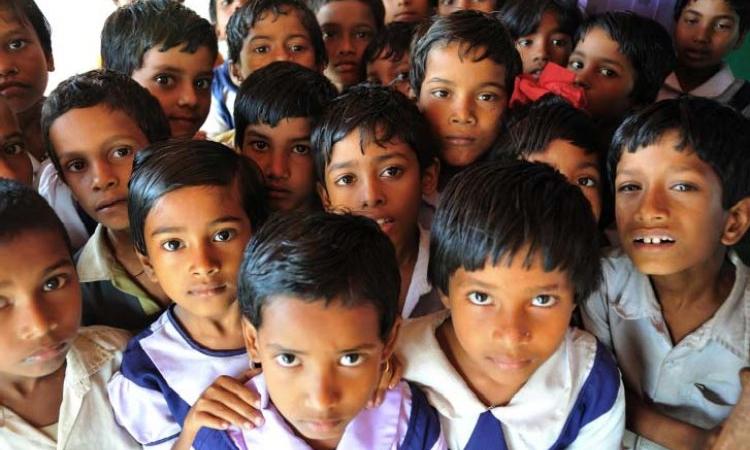
A pig snorts after emerging from the open drain that passes through a slum in the Digha area of south Patna. Small children crawl on the road nearby with slime dribbling from their nose. Children can be seen picking through garbage at the local dump and for ghongha (snails) at the local talaab (pond).
This slum houses a community of musahars, a marginalized group of Scheduled Caste people who were traditionally rat catchers. Settled near the Ganges river in unauthorized constructions, the musahars today mainly work as unskilled labourers.
People here do not have rights to the land they are living on. Some houses here double up as pigsties. They live in the most insanitary conditions and defecate in the open, which in turn leads to the spread of fecal-oral disease and parasitic infestation. This, along with increasing malnutrition among children is leading to arrested growth, manifesting in the form of low weight, stunted height, low IQ and a high rate of under-five mortality.
Sadly, this is a fairly typical case of unsanitary conditions in many parts of India.
A growing body of literature (Robert Chambers et al, Dianne Coffey et al) has established that open defecation plays a key role in solving the puzzle of persistent childhood malnutrition in India. As per Dean Spears et al, poor sanitation facilities and open defecation are a grave public health concern, and are directly correlated with restricted growth in children, which results in premature mortality.
A new study - ‘Child health and unhealthy sanitary practices in India’ published in April 2019, establishes inter-linkages between sanitation and child health using data from the fourth round of the cross-sectional National Family Health Survey (NFHS-4, 2015–16). The NFHS for the first time provides district-level estimates for many important indicators, gathering information from 601,509 households, 699,686 women, and 103,525 men. The present study on child health and unsafe sanitation, uses data of those births which took place five years preceding the date of survey. This study uses 259,627 births of children born to 190,898 women across India.
The study looks at four key parameters in several states, listed below.
- Improved sanitation
- Safe stool disposal
- Stunting in children and
- Under five mortality
The third and fourth parameters, stunting and mortality of children under the age of 5 years, are proxy indicators that have been used to assess overall effect on child health.
Patterns of practicing improved sanitation and safe stool disposal
The results were surprising. Overall, only 38% of households reported using improved sanitation facilities in India, and just about one third of households were following safe stool disposal practices. Half of the states in India are still under 50% coverage of improved sanitation facilities.
The situation in the central and eastern parts of India, was found to be the most dire. States in these two regions except West Bengal (42.4%) have not even attained 30% of improved sanitation coverage.
In the case of safe stool disposal - where stool is either disposed of in a latrine or buried - the eastern and central regions again performed poorly with Odisha being the lowest – just 11% of households were reported to be practicing safe stool disposal.
In addition, Assam was found to have 18.5% of households practicing safe disposal of stool; Andhra Pradesh has 27.5% and Rajasthan has 29.9%, ranking among the poorest performers in terms of adopting safe stool disposal practices in other parts of the country.
Overall, the percentage of households using improved sanitation facilities and safe stool disposal practices was found to be far from satisfactory.
A map visualising the 4 data points in this study- improved sanitation coverage, safe stool disposal, stunting and under 5 mortality state-wise. Click on the icon in the top left of the map to see the 4 data points together or in isolation from each other.
Distribution of stunting and under-five mortality
39% of children below the age of five in India were found to be stunted. Bihar performed the worst, with almost half of children found to be stunted (48.4%), closely followed by Uttar Pradesh, Jharkhand, Meghalaya and Madhya Pradesh with 46.3%, 45.5%, 43.9% and 41.9% children stunted, respectively.
States like Kerala and Goa, which have performed satisfactorily in terms of health sanitary practices and other social indicators, were observed to have 20% of children that were stunted. Uttar Pradesh was reported to have the highest under-five mortality rate, followed by Madhya Pradesh and Chhattisgarh. Kerala with an under-five mortality rate of 7 displayed the lowest under-five deaths, followed by Goa with 13 under-five deaths per 1000 live births.
Across all the sub-population categories, there were higher numbers of stunted children under the age of five, and a higher under-five mortality rate in households where improved sanitation facilities were not available and safe stool disposal practices were not followed. A decline of 10% to 20% was observed in the prevalence of stunting under these categories where improved sanitation facilities were available and safe stool disposal was practiced.
Way forward
If all households in India practice safe stool disposal for their children, there can be a significant reduction in under-five child mortality. In a country like India, only providing access to sanitation does not ensure hygienic sanitation practices.
Empirical evidence from the study shows the benefits of using improved sanitation facilities and practicing safe stool disposal, to reduce childhood stunting and premature deaths. The study recommends that rural communities in particular, should be made more aware of the risks of unhealthy sanitary practices.
A few studies found that teachers and natural leaders from socially cohesive villages are efficient mediators in encouraging behavioural changes in their communities. The main behavioural change that needs to be brought about among people is to improve neighbourhood cleanliness levels and to help children live healthier childhoods, and hence healthier, vastly improved lives as adults in the long run.
/articles/whats-shit-got-do-child-health